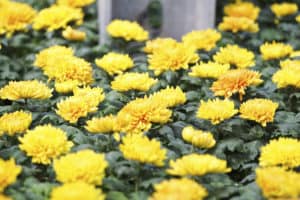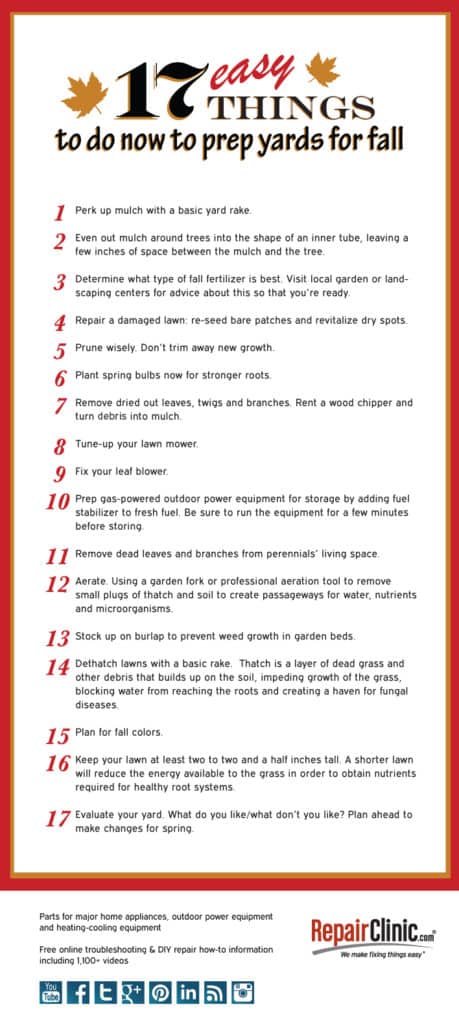To prepare your yard for fall, focus on 17 easy tasks that will improve its health and reduce future maintenance. Jeff Linderman suggests creating mulch from twigs and branches using a wood chipper, aerating the soil with a garden fork, and mowing grass carefully to maintain healthy roots. For maintenance products, consider visiting RepairClinic.com for replacement parts and resources on outdoor power equipment.
1. Perk up mulch.
Use a basic yard rake to redistribute mulch. This will enable water to get to the roots faster.
2. Even out mulch around trees.
“A common mistake is to pile mulch tall like a mountain,” said Linderman. “This makes it more attractive to pests. It’s best to even out the mulch around the trees in the shape of an inner tube, leaving few inches of space between the mulch and the tree.”
3. Determine what type of fall fertilizer is best.
“In most parts of the United States and Canada, fall is the most important time of the year to fertilize lawns,” said Linderman. “Applying fertilizer in fall will result in a far healthier spring lawn. Unfortunately, many people don’t take the time to figure out what kind of fertilizer is best for their region and yard conditions. It’s wise to visit local garden or landscaping centers for advice about this so that you’re ready.”
4. Repair a damaged lawn.
Late summer provides good opportunity to re-seed bare patches and revitalize dry spots before the temperatures drop and lawn growth slows.
5. Prune wisely.
“Pruning of bushes and other vegetation should be done with great care,” said Linderman. “It’s easy to over-prune. You don’t want to trim away new growth.”
6. Plant spring bulbs now.
In most regions, planting spring bulbs now, rather in than in spring, is wise because it provides a longer period for roots to strengthen.
7. Remove dried out leaves, twigs and branches.
In lieu of burning them, turn them into nutrient-rich mulch for your lawn.
“It’s easy to create mulch from twigs and branches using a wood chipper,” said Linderman. “Wood chippers are available to rent from home improvement stores at an affordable rate.”
8. Tune-up your lawn mower.
Tune up your lawn mower to improve efficiency, reduce emissions, prevent end-of-summer breakdowns and get it ready for off-season storage.
9. Fix and/or tune up your leaf blower.
Test your leaf blower and repair any problems to avoid any fall downtime.
RepairClinic.com has replacement parts and maintenance products for leaf blowers.
10. Prep gas-powered outdoor power equipment for storage by adding fuel stabilizer to fresh fuel and then running the equipment for a couple of minutes.
This will prevent buildup within the carburetor.
11. Remove dead leaves and branches from perennials.
“Clear dead leaves and fallen fruit from your perennials’ living space to reduce its pest appeal,” said Linderman.
12. Aerate.
Aeration is the process of moving air between soil and its surroundings. It plays an important role in the healthy growth of grass. It occurs naturally but the development of thatch (a mix of dead grass and other debris) makes it more difficult for this to happen on its own.
“Using a garden fork or professional aeration tool, remove small plugs of thatch and soil to foster natural aeration,” Linderman said. “Creating passageways will enable greater water intake, make way for valuable microorganisms and worms, maximize the benefits of fertilizer, promote healthier roots and make the lawn more heat and drought tolerant.”
13. Stock up on burlap.
“Burlap is an inexpensive way to prevent weed growth in garden beds,” said Linderman.
14. Dethatch lawns.
Thatch, which is a layer of dead grass and other debris, can build up on the soil, impeding growth of the grass, blocking water from reaching the roots and creating a haven for fungal diseases. Before fall leaves hit the surface, remove thatch using a basic rake.
15. Plan for fall colors.
“Even if summer blooms are still thriving, think about mums and other staple fall flowers that you’ll use in their place,” said Linderman.
16. Keep your lawn at least two to two and a half inches tall.
“By the end of the summer, many people have yardcare fatigue,” said Linderman. “They may adjust their lawn mower’s cutting height to cut the lawn shorter to reduce required mowing. This can cause lawn health problems.”
Cut only one third of grass blade length in a single mowing. Shortening the blades will reduce the energy available to the grass in order to obtain nutrients required for healthy root systems.
17. Evaluate your yard and plan ahead.
“Take the time now to think about what you like about your yard and what needs improvement,” said Linderman. “Residential landscaping should always evolve. Figure out how you want your yard to be different in the spring. You’ll likely find that there are many things you need to do now to make it easier when the new season arrives.”
###
RepairClinic.com® makes fixing things easy for millions of people. Founded in 1999, it’s North America’s trusted online store with replacement parts for outdoor power equipment, major household appliances and heating and cooling equipment. Free repair resources including more than 1,200 how-to videos empower people to fix stuff on their own. One million parts for 160 brands are stocked at its 86,000-square-foot facility in Canton, Michigan. Do-it-yourselfers also appreciate its generous, no-hassle 365 Days. Period.® return policy. In-stock parts are guaranteed to ship the same business day. Visit RepairClinic.com for more information. Contact Jody Lamb, Public Relations Manager, at JLamb [at] RepairClinic.com.
Any quotes from this release may be attributed to Jeff Linderman, RepairClinic.com’s landscaping specialist and outdoor power equipment technician.



Comments are closed.